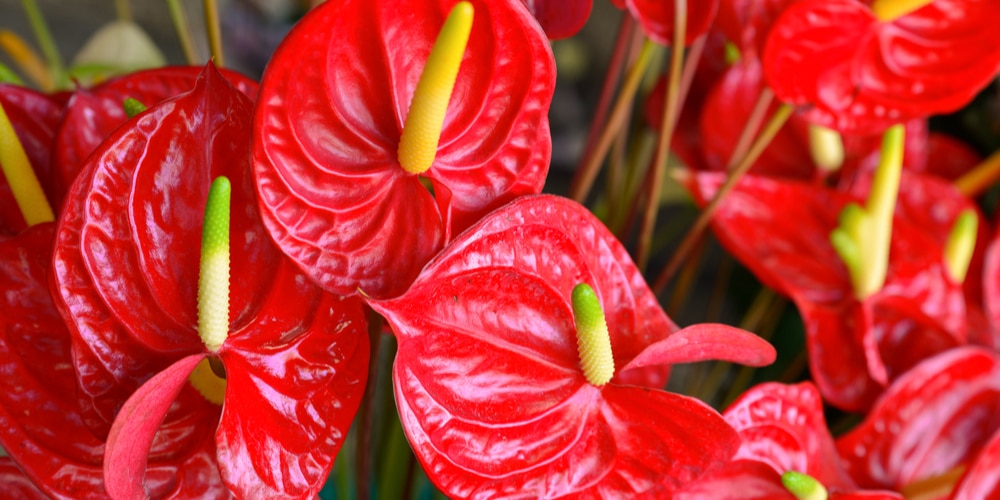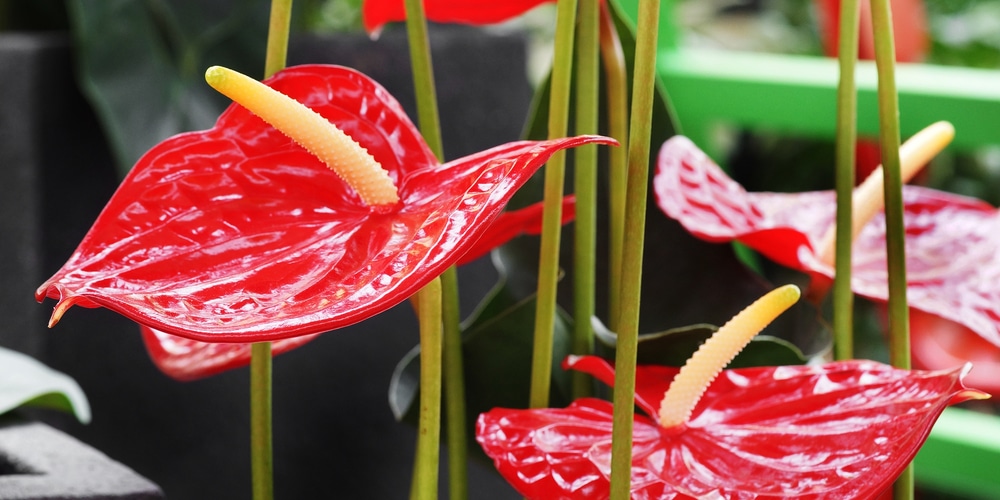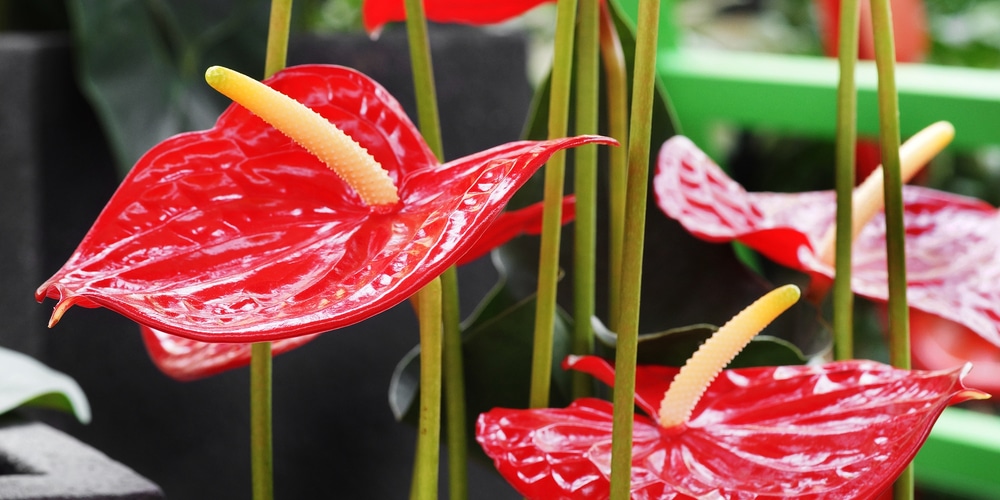Anthuriums are, undoubtedly, one of the best plants for the home gardener. The bright colours and resounding beauty of these plants make them a great addition to any garden. You may be wondering, ‘how to make anthurium bloom?’
It’s easy to tell why they are so popular, but it’s also easy to see how they can become a little bit difficult as well. There are times when your anthurium just won’t bloom, and you keep wondering what you are doing wrong.
Well, you have to understand that these plants are quite sensitive when it comes to the perfect thriving environment.
And it’s not only that, but issues like lighting and soil quality are also major determinants in the overall well-being of your plant. You can, therefore, make your plant happy by providing it with enough indirect sunlight, appropriate humidity, adequate phosphorous-rich fertilizer, and sufficient water.
How to make anthurium bloom
A happy anthurium is a bloomy anthurium.
So, if your anthurium is not blooming the way you want it to, here are some remedies that you should consider:
1. Use the right potting mixture
Anthuriums prefer well-drained soils that are not too dense for their roots. In truth, the perfect potting soil for anthuriums is the one with the capability to drain speedily. Coarse potting soil with a generous amount of additions for increased aeration will do your plant good.
Some of the best additives that you can use to loosen up your anthurium’s soil include but are not limited to:
- Perlite
- Gravel
- Coconut coir
- Peat moss
- Fir bark
- Compost
You may want to experiment until you find the best mix for your plant if you’re not getting the desired results with the above additives.
2. Be careful with the watering
Did you know that watering is one of the aspects of growing an indoor plant that the majority of the home gardeners don’t get right? What’s even worse is that inappropriate watering has the most adverse effects on your plant than any other error.
Anthuriums are super sensitive to excess water and will have their flowering impaired by overwatering. What’s more, if you keep overwatering your anthurium, don’t be surprised when it becomes affected by root rot.
At this point, your plant will be approaching the point where recovery from overwatering becomes almost impossible.
To avoid overwatering, you should test the soil using your finger or a moisture meter for better accuracy. Only water when the soil has dried out to 1-2.5 inches, which is roughly the depth of the first knuckle of your index finger. When watering, pour out the water until it starts dripping from the drainage holes.
Make sure to always watch out for signs of overwatering. The most common ones are yellowing leaves coupled with brown, shrivelled lead tips.
3. See to it that the pot drains well
Just like overwatering, a pot that does not drain like it’s supposed to will expose your plant to root rot. It doesn’t matter that you’re not overwatering your plants – you will want to get a pot that drains off the excess liquid in it to avoid waterlogging.
If you want to enhance the drainage of your pot, even more, place pebbles on the base of the pot before adding the soil. Just don’t use the pebbles as a way to increase drainage in a pot that doesn’t have holes. If you have to drill in the holes, then do it – the extra effort will save your plant.
4. What’s that? Some light at the end of the tunnel?
Anthuriums love indirect sunlight, taking into consideration that in their natural habitat, they grow under the canopy of trees. If you’re going to use a grow lamp, be sure to keep it on for at least 12 hours and at most 16 hours. That way, your plant is going to have an ideal sleeping time of 8-12 hours.
On the other hand, relying on sunlight means that you should try your best to protect the plant from direct sunlight. There is no shame in using a shade cloth to protect your anthurium from excess sunlight.
Even better, you can place the anthurium under a larger broadleaf plant to mimic the plant’s natural habitat. Just keep in mind that too much or too little light is not good for a blooming anthurium. Too little light will stop the flowering process completely, while too much light causes discolouration.
5. Fertilize your plant, but do it cautiously
In some cases, you have to increase the chances of your Anthurium blooming by boosting its diet. While in the wild, these plants are exposed to a weak stream of nutrients from the rain and scraps of decaying plants.
Feeding your plant with diluted doses of fertilizer that has enough phosphorous in it (orchid fertilizers are a good choice) ideally once a week after watering will keep it healthy and wanting to bloom.
Just be sure not to overfertilize your plant. One of the signs that you’ve overfertilized is the browning of leaves. If you suspect that you’ve overfed your plant, you’ll want to flush the excess nutrients by flushing the soil. Actually, flushing the soil can give you a better idea of whether it’s draining as fast as is required.
6. Provide humid conditions
One thing that you have to keep in mind when growing a rainforest plant is that it thrives best in a humid environment. Get a small spray bottle and mist your anthurium often enough. If you’re quite busy or you just love automation, opt for a small humidifier that you’ll have to place near the plant.
You might be wondering why you have to grow anthuriums in a humid environment, yet they are sensitive to excess water. In such a case, you’d have to understand that there is a difference between humid air and wet soil.
Being epiphytes means that anthuriums get most of their water from the air around them while in their natural environment. As such, replicating these conditions means that your plant will feel right at home, and confident to bloom.
Anthurium care summary
- Potting mix: Well-drained potting mixture with additives for enhanced drainage
- Humidity: High
- Fertilizing: Weekly, using phosphorus-rich liquid fertilizer that has been diluted to 10-20% of its strength
- Temperature: 21-29°C/10-85°F
- Watering: Dried out potting mixture between watering sessions
- Light: 12-16 hours artificial light/all-day indirect sunlight
- Repotting: After every 2 years
How to make anthurium bloom: Conclusion
Growing an anthurium is not hard. However, there are a lot of steps that you need to take to achieve the best results.
If you follow the instructions in this article and get a few pointers from other growers in your area, it won’t take long before your plant blooms for the first time.
Related Article: Is Anthurium toxic to cats?


